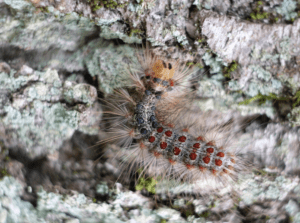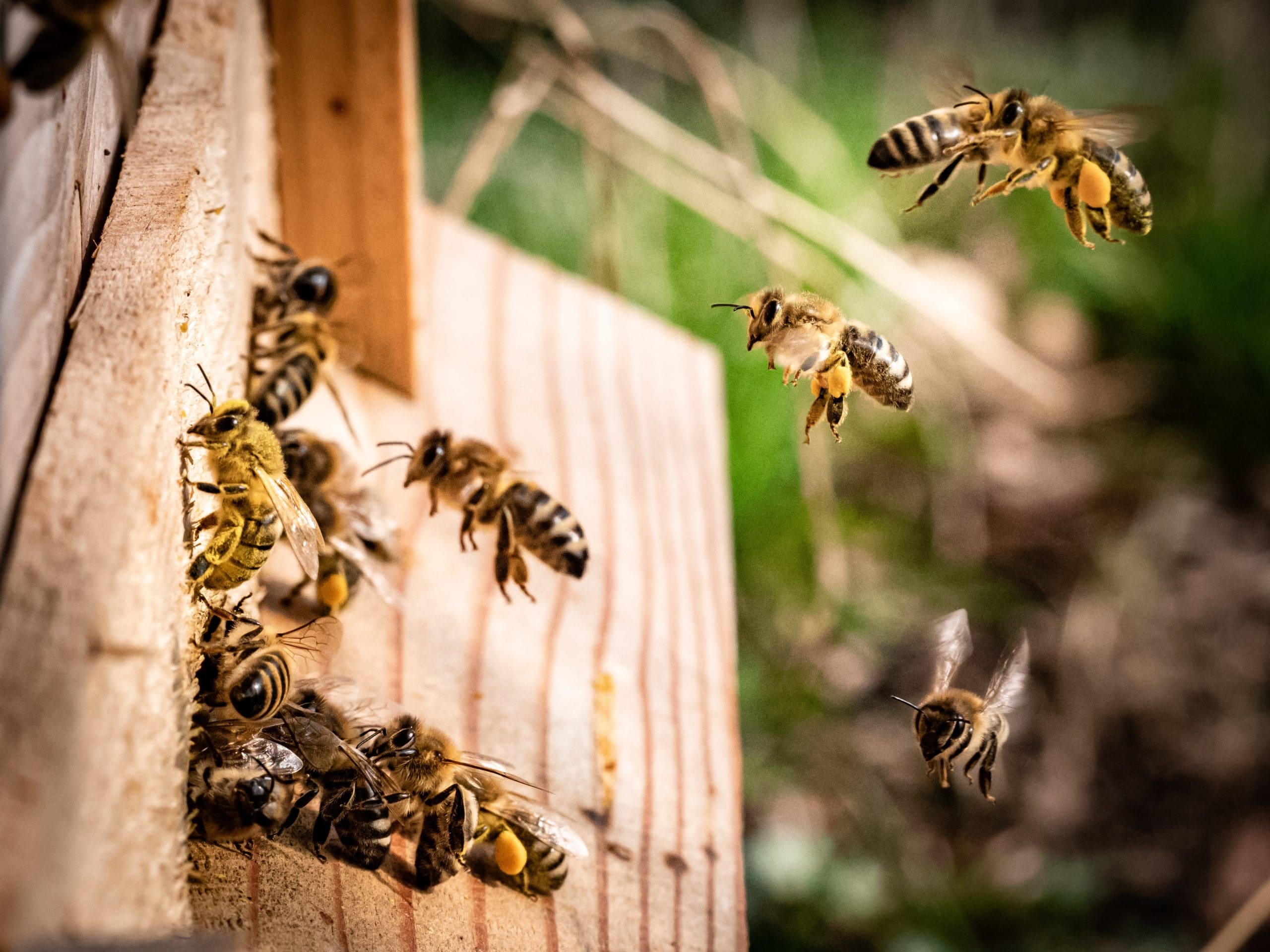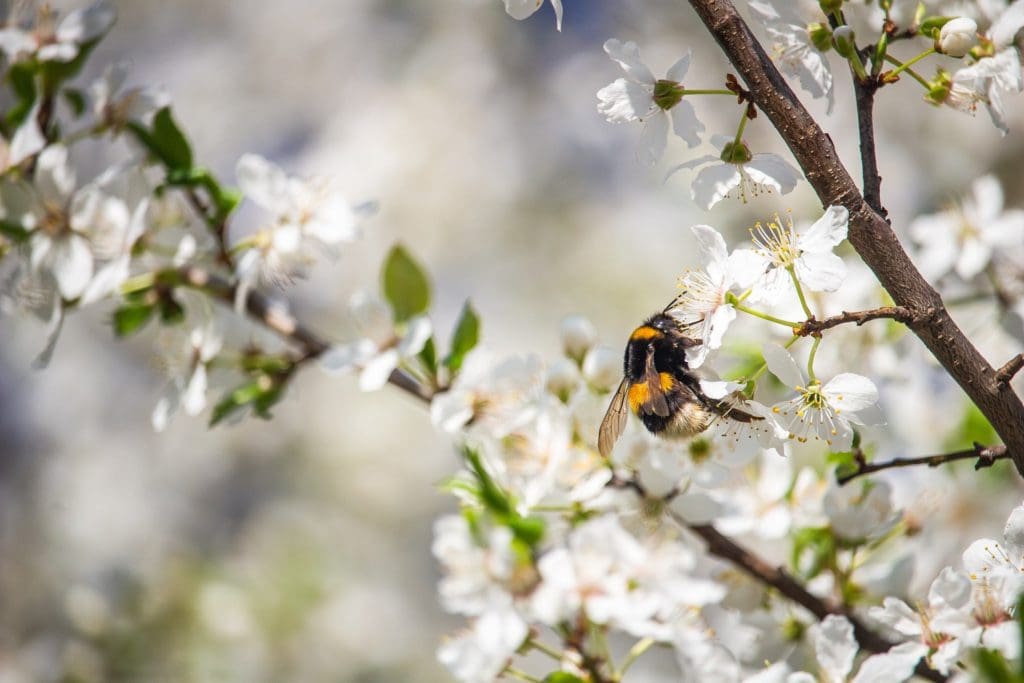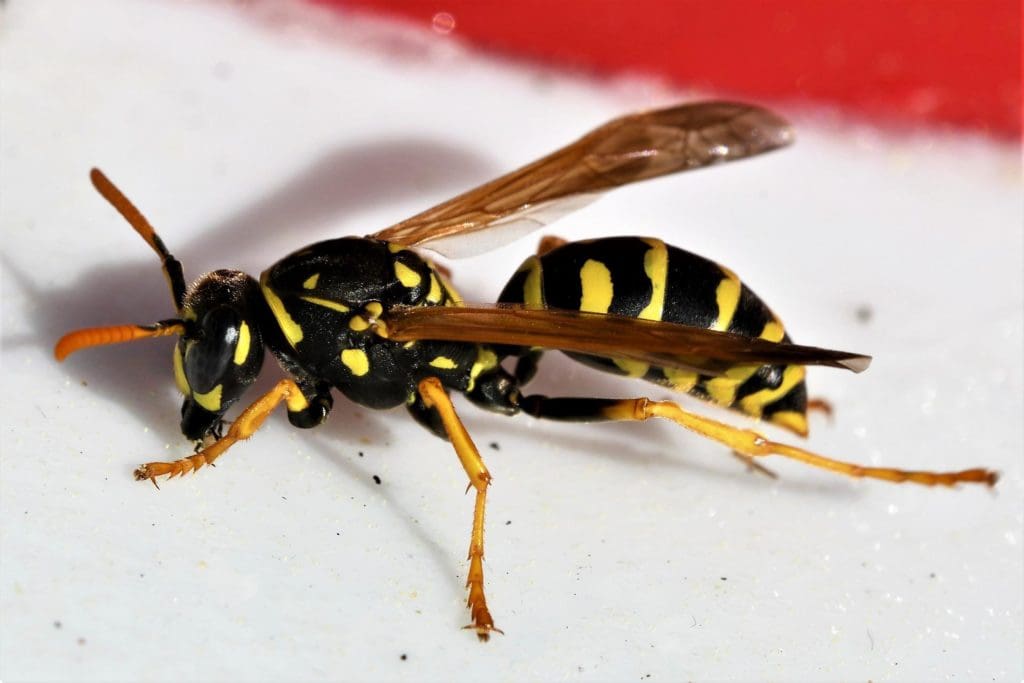

The weather is finally warming up again, which means the bugs are back in town- including bees and wasps. It can sometimes be hard to tell the difference between the two insects, but differentiating is important when deciding how to deal with them on your property. This guide will help you identify the differences between bees and wasps, as well as common species of each.

 Bumblebees
These bees are very round and hairy. They are roughly ¼ to 1 inch in length with black and yellow stripes on their whole body. Bumblebees are social.
Carpenter bees
Carpenter bees resemble bumblebees in size and shape. Unlike bumblebees, their abdomens are hairless and all black. The males’ faces are yellow while the females’ faces are black. Carpenter bees are solitary.
Sweat Bees
Sweat bees are rather small, only growing to be around ¾ of an inch long. Their bodies are slender and they are typically either bright metallic green or brownish-black with light-colored bands on their abdomens.
Mining Bees
Also known as chimney bees, mining bees are typically 12 to 17mm in length. There are a number of species of mining bees and they range in color. Some have brighter colors and some are more drab. Quite a few species are reddish-gold. Others are yellow and black, so they are often mistaken for bumblebees. Mining bees are solitary.
Bumblebees
These bees are very round and hairy. They are roughly ¼ to 1 inch in length with black and yellow stripes on their whole body. Bumblebees are social.
Carpenter bees
Carpenter bees resemble bumblebees in size and shape. Unlike bumblebees, their abdomens are hairless and all black. The males’ faces are yellow while the females’ faces are black. Carpenter bees are solitary.
Sweat Bees
Sweat bees are rather small, only growing to be around ¾ of an inch long. Their bodies are slender and they are typically either bright metallic green or brownish-black with light-colored bands on their abdomens.
Mining Bees
Also known as chimney bees, mining bees are typically 12 to 17mm in length. There are a number of species of mining bees and they range in color. Some have brighter colors and some are more drab. Quite a few species are reddish-gold. Others are yellow and black, so they are often mistaken for bumblebees. Mining bees are solitary.
 Mud Daubers
These wasps are easily identified by their long, narrow waists. Their bodies are ½ to 1 inch in length. They range in color, but most are yellow and black, metallic blue, or just plain black. Mud Daubers are solitary.
Hornets
There are two species of hornets in the U.S.- the European hornet and the bald faced hornet. European hornets are 1 to 1½ inches long. Their thoraxes are reddish-brown and black, and their abdomens are yellow and black with a teardrop pattern. Bald faced hornets are roughly 1 inch long with mostly white faces. Their bodies are black with white markings. Bald faced hornets are actually closer relatives to yellow jackets than to other hornets. They are classified as hornets due to their nesting habits and size. Hornets are social.
Yellow Jackets
Yellow jackets are smaller wasps, only reaching 10-16mm long. Their abdomens have yellow and black bands. Some yellow jackets have very light yellow, almost white coloring. Yellow jackets are social.
Paper Wasps
Paper wasps reach between ¾ and 1 inch in length. They are either brown and yellow or reddish-brown in color and they have smoky black wings. Paper wasps are social.
If you’re noticing more bees or wasps than normal around your property this season, you may have a nest nearby. Give Twin-Boro a call, and we’ll send over an expert technician right away.
Mud Daubers
These wasps are easily identified by their long, narrow waists. Their bodies are ½ to 1 inch in length. They range in color, but most are yellow and black, metallic blue, or just plain black. Mud Daubers are solitary.
Hornets
There are two species of hornets in the U.S.- the European hornet and the bald faced hornet. European hornets are 1 to 1½ inches long. Their thoraxes are reddish-brown and black, and their abdomens are yellow and black with a teardrop pattern. Bald faced hornets are roughly 1 inch long with mostly white faces. Their bodies are black with white markings. Bald faced hornets are actually closer relatives to yellow jackets than to other hornets. They are classified as hornets due to their nesting habits and size. Hornets are social.
Yellow Jackets
Yellow jackets are smaller wasps, only reaching 10-16mm long. Their abdomens have yellow and black bands. Some yellow jackets have very light yellow, almost white coloring. Yellow jackets are social.
Paper Wasps
Paper wasps reach between ¾ and 1 inch in length. They are either brown and yellow or reddish-brown in color and they have smoky black wings. Paper wasps are social.
If you’re noticing more bees or wasps than normal around your property this season, you may have a nest nearby. Give Twin-Boro a call, and we’ll send over an expert technician right away.
What is a Bee?
Bees are flying insects with wide, visibly hairy bodies. They vary in appearance quite a bit from species to species, but all bees share the same basic build of a head, thorax, and abdomen. They each have segmented antennae on their heads as well as four wings and six flat legs on their thoraxes. Their “waist”, known as a petiole, connects the thorax to the abdomen. A bee’s stinger is on the end of its abdomen. Bees emit a very distinct buzzing noise when they fly. Larger bees create a louder buzz. Around 90% of bee species are solitary, meaning they live alone in small nests. The other 10% are social, meaning they live among colonies in larger nests.-
- Are Bees Dangerous?

-
- Bee condos provide safe housing to bees who can’t find a place to make a nest. They can be built or bought, and they are small enough to fit in any size garden- even a window box!
-
- Plant a garden just for the bees. Plant flowers bees prefer, like echinacea, hosta, goldenrod, sunflowers, catnip, chives, and bee balm.
-
- Avoid pesticide use as much as possible. The chemicals may take care of the pests, but they kill the helpful bugs too!
-
- To save the bees we have to save the trees! Bees need trees for food, shelter, and nest building resources. Deforestation is taking a toll on bee populations.
-
- Make a bee bath so the bees on your property have a place to stop for a drink.
-
- Spreading awareness is one of the most important steps toward saving the bees. Encourage those around you to protect the bees as well.
What is a Wasp?
Wasps are winged insects with slender bodies. Their broad heads have segmented antennae and a biting mouthpart. Attached to the head is the thorax, which is home to the wings and thin, cylindrical legs. A wasp’s petiole is very narrow. Wasps have tiny hairs on their bodies, but these hairs are almost invisible to the naked eye. As a result, they appear shiny. Like bees, wasps are split into the subdivisions of solitary and social. Most species of wasp are solitary.-
- Are Wasps Dangerous?
-
- Bees are wider and hairier than wasps.
-
- Wasps have more noticeably segmented bodies and narrower waists than bees.
-
- Bees have flat, hairy legs while wasps have cylindrical, hairless legs.
-
- Bees have barbed stingers and can sting only once. Wasps do not have barbed stingers and can sting many times.
-
- Wasps are usually more aggressive than bees.
Bee Species Identification
Honey Bees Honey bees have hair almost everywhere on their bodies, including their eyes. They grow to be around 15mm long, and they are mustard yellow and brown. Honey bees are social. Bumblebees
These bees are very round and hairy. They are roughly ¼ to 1 inch in length with black and yellow stripes on their whole body. Bumblebees are social.
Carpenter bees
Carpenter bees resemble bumblebees in size and shape. Unlike bumblebees, their abdomens are hairless and all black. The males’ faces are yellow while the females’ faces are black. Carpenter bees are solitary.
Sweat Bees
Sweat bees are rather small, only growing to be around ¾ of an inch long. Their bodies are slender and they are typically either bright metallic green or brownish-black with light-colored bands on their abdomens.
Mining Bees
Also known as chimney bees, mining bees are typically 12 to 17mm in length. There are a number of species of mining bees and they range in color. Some have brighter colors and some are more drab. Quite a few species are reddish-gold. Others are yellow and black, so they are often mistaken for bumblebees. Mining bees are solitary.
Bumblebees
These bees are very round and hairy. They are roughly ¼ to 1 inch in length with black and yellow stripes on their whole body. Bumblebees are social.
Carpenter bees
Carpenter bees resemble bumblebees in size and shape. Unlike bumblebees, their abdomens are hairless and all black. The males’ faces are yellow while the females’ faces are black. Carpenter bees are solitary.
Sweat Bees
Sweat bees are rather small, only growing to be around ¾ of an inch long. Their bodies are slender and they are typically either bright metallic green or brownish-black with light-colored bands on their abdomens.
Mining Bees
Also known as chimney bees, mining bees are typically 12 to 17mm in length. There are a number of species of mining bees and they range in color. Some have brighter colors and some are more drab. Quite a few species are reddish-gold. Others are yellow and black, so they are often mistaken for bumblebees. Mining bees are solitary.
Wasp Species Identification
 Mud Daubers
These wasps are easily identified by their long, narrow waists. Their bodies are ½ to 1 inch in length. They range in color, but most are yellow and black, metallic blue, or just plain black. Mud Daubers are solitary.
Hornets
There are two species of hornets in the U.S.- the European hornet and the bald faced hornet. European hornets are 1 to 1½ inches long. Their thoraxes are reddish-brown and black, and their abdomens are yellow and black with a teardrop pattern. Bald faced hornets are roughly 1 inch long with mostly white faces. Their bodies are black with white markings. Bald faced hornets are actually closer relatives to yellow jackets than to other hornets. They are classified as hornets due to their nesting habits and size. Hornets are social.
Yellow Jackets
Yellow jackets are smaller wasps, only reaching 10-16mm long. Their abdomens have yellow and black bands. Some yellow jackets have very light yellow, almost white coloring. Yellow jackets are social.
Paper Wasps
Paper wasps reach between ¾ and 1 inch in length. They are either brown and yellow or reddish-brown in color and they have smoky black wings. Paper wasps are social.
If you’re noticing more bees or wasps than normal around your property this season, you may have a nest nearby. Give Twin-Boro a call, and we’ll send over an expert technician right away.
Mud Daubers
These wasps are easily identified by their long, narrow waists. Their bodies are ½ to 1 inch in length. They range in color, but most are yellow and black, metallic blue, or just plain black. Mud Daubers are solitary.
Hornets
There are two species of hornets in the U.S.- the European hornet and the bald faced hornet. European hornets are 1 to 1½ inches long. Their thoraxes are reddish-brown and black, and their abdomens are yellow and black with a teardrop pattern. Bald faced hornets are roughly 1 inch long with mostly white faces. Their bodies are black with white markings. Bald faced hornets are actually closer relatives to yellow jackets than to other hornets. They are classified as hornets due to their nesting habits and size. Hornets are social.
Yellow Jackets
Yellow jackets are smaller wasps, only reaching 10-16mm long. Their abdomens have yellow and black bands. Some yellow jackets have very light yellow, almost white coloring. Yellow jackets are social.
Paper Wasps
Paper wasps reach between ¾ and 1 inch in length. They are either brown and yellow or reddish-brown in color and they have smoky black wings. Paper wasps are social.
If you’re noticing more bees or wasps than normal around your property this season, you may have a nest nearby. Give Twin-Boro a call, and we’ll send over an expert technician right away. 





